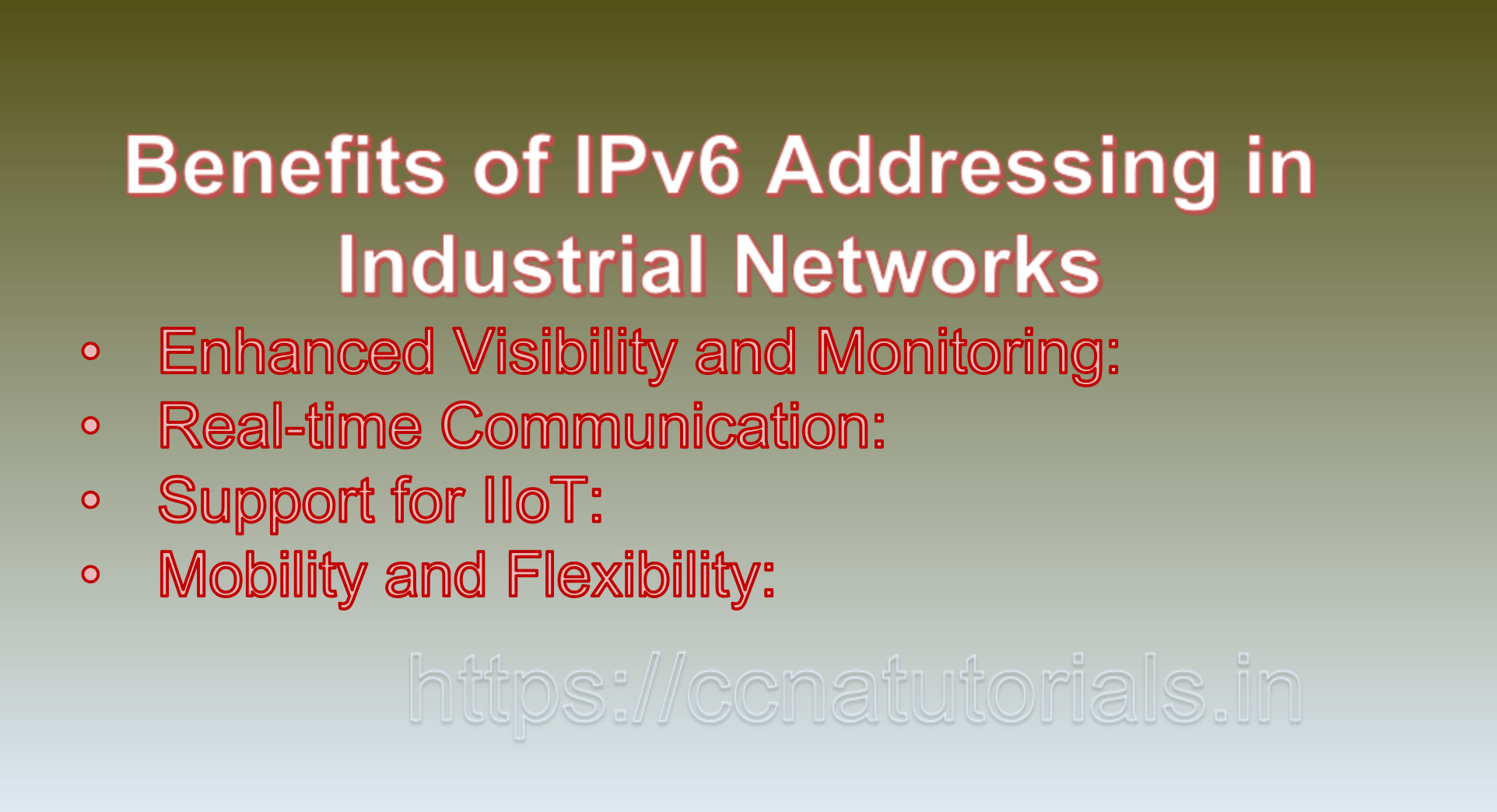Contents of this article
In this article, I describe IPv6 Addressing in Industrial Networks: Enabling Connectivity and Efficiency in Industrial Automation. Industrial networks play a crucial role in modern manufacturing, automation, and control systems. As the Industrial Internet of Things (IIoT) gains momentum, the need for efficient and scalable networking solutions becomes paramount. IPv6 addressing offers a robust framework to address the challenges and demands of industrial networks. In this article, we’ll provide a concise overview of IPv6 addressing in industrial networks, discussing its importance, benefits, implementation, and considerations.
Understanding IPv6 Addressing in Industrial Networks
Industrial networks encompass a diverse range of devices, sensors, controllers, and systems that collectively enable automation, monitoring, and control in industrial settings. These networks require reliable and efficient communication to ensure the smooth operation of critical processes. IPv6 addressing, with its expanded address space and advanced features, is well-suited to meet the unique requirements of industrial networks.
Importance of IPv6 Addressing in Industrial Networks
1. Scalability:
IPv6 introduces a 128-bit address space, allowing for an astronomical number of unique addresses. This scalability is crucial as industrial networks often involve a multitude of devices, from sensors to machinery, and the IIoT is expected to exponentially increase the number of connected devices.
2. End-to-End Connectivity:
IPv6 provides direct, end-to-end communication between devices without the need for Network Address Translation (NAT). This is particularly beneficial in industrial networks where seamless communication between devices is essential for real-time control and monitoring.
3. Efficient Network Design:
The hierarchical structure of IPv6 addressing enables efficient network segmentation and organization. Industrial networks can be divided into subnets based on physical location, production processes, or security requirements, allowing for optimized network management.
4. Autoconfiguration:
IPv6 offers Stateless Address Autoconfiguration (SLAAC), enabling devices to self-configure their addresses without manual intervention. This is valuable for industrial settings where devices may need to be deployed quickly and in remote locations.
Benefits of IPv6 Addressing in Industrial Networks
1. Enhanced Visibility and Monitoring:
Each device in an industrial network can be assigned a unique IPv6 address, enabling centralized monitoring and control. Operators can easily identify and manage devices, leading to better visibility into operations.
2. Real-time Communication:
IPv6’s direct communication capabilities are ideal for industrial applications that demand real-time control, such as robotics and automation. Devices can exchange data without intermediate translation, reducing latency.
3. Support for IIoT:
The IIoT relies on seamless connectivity between various devices and systems. IPv6 addressing ensures that IIoT devices, whether sensors or actuators, can communicate efficiently and securely.
4. Mobility and Flexibility:
Industrial environments often involve mobile devices like AGVs (Automated Guided Vehicles) or handheld terminals. IPv6’s support for mobility ensures that devices can move within the network without changing their IP addresses.
IPv6 Addressing Implementation in Industrial Networks
1. Unique Device Addresses:
Each device in an industrial network is assigned a globally unique IPv6 address. This ensures that devices can be accurately identified and communicated with within the network.
2. Network Segmentation:
IPv6’s hierarchical addressing allows for efficient network segmentation. Subnets can be created for different departments, production lines, or zones, enabling targeted management and monitoring.
3. SLAAC and DHCPv6:
Industrial devices can use Stateless Address Autoconfiguration (SLAAC) or DHCPv6 (Dynamic Host Configuration Protocol for IPv6) to obtain IPv6 addresses. SLAAC offers plug-and-play simplicity, while DHCPv6 provides centralized address assignment and configuration.
4. Security Considerations:
Security is crucial in industrial networks. IPv6 features like IPsec (Internet Protocol Security) can be used to encrypt and secure data communication between devices, protecting against unauthorized access and data breaches.
Considerations and Challenges
1. Legacy Systems:
Migrating to IPv6 in industrial networks may involve dealing with legacy systems that only support IPv4. Transition mechanisms and compatibility solutions are needed to ensure smooth integration.
2. Security:
While IPv6 provides advanced security features, ensuring proper implementation and management of security protocols is essential to protect critical industrial infrastructure from cyber threats.
3. Address Management:
With the potential for a vast number of devices, managing IPv6 addresses efficiently becomes crucial. Address planning, assignment, and tracking tools are necessary to avoid address exhaustion and conflicts.
4. Configuration Complexity:
While SLAAC simplifies device configuration, some industrial devices may require specific configuration settings. Implementing and managing DHCPv6 for such devices can be more complex.

A short overview of IPv6 Addressing in Industrial Networks
IPv6 addressing is a fundamental component that addresses the unique demands of industrial networks in the era of IIoT. Its scalability, end-to-end connectivity, and support for efficient network design make it an ideal choice for the connectivity needs of industrial automation, manufacturing, and control systems. By embracing IPv6, industrial networks can harness the power of connected devices, streamline operations, and enhance real-time communication, ultimately contributing to increased efficiency, productivity, and innovation in the industrial landscape.
IPv6 Addressing in Industrial Networks: Enabling Connectivity and Efficiency in Industry 4.0
Industrial networks are undergoing a transformative shift with the advent of Industry 4.0, marked by the integration of advanced technologies and the Internet of Things (IoT) into industrial processes. IPv6 addressing plays a crucial role in facilitating the connectivity, scalability, and security required for modern industrial networks. In this article, we’ll explore the significance of IPv6 addressing in industrial networks, its benefits, implementation considerations, and examples to illustrate its relevance in the context of Industry 4.0.
Understanding IPv6 Addressing in Industrial Networks: An Overview
IPv6, the sixth version of the Internet Protocol, was developed to overcome the limitations of its predecessor, IPv4, and to accommodate the growing number of devices in an increasingly connected world. In industrial networks, IPv6 addressing serves as the foundation for enabling seamless communication among machines, sensors, controllers, and other devices. With its larger address space and features designed for IoT, IPv6 addresses the challenges of scale, mobility, and security in the industrial landscape.
Benefits of IPv6 Addressing in Industrial Networks
1. Scalability:
IPv6’s 128-bit address space provides an extensive range of unique addresses, allowing industrial networks to accommodate a multitude of devices, sensors, and machines. This scalability is crucial as Industry 4.0 introduces a surge of connected assets.
2. End-to-End Connectivity:
Each device in an industrial network can be assigned a globally unique IPv6 address, enabling direct communication between devices and eliminating the need for complex network address translation (NAT) setups.
3. Autoconfiguration:
IPv6 incorporates Stateless Address Autoconfiguration (SLAAC), enabling devices to self-assign addresses and join the network without manual configuration. This is especially useful in large-scale industrial deployments.
4. Mobility Support:
IPv6’s design allows for seamless mobility of devices within the network. This is vital for scenarios where machinery or sensors need to be relocated or where mobile robots operate within industrial environments.
5. Efficient Hierarchical Addressing:
IPv6’s hierarchical addressing structure aids in organizing industrial networks into segments or subnets based on location, function, or security requirements, enhancing network management.
Implementation Considerations
1. Addressing Plan:
Developing a comprehensive addressing plan is essential to efficiently manage devices, prevent address conflicts, and ensure consistency across the network.
2. Network Management:
Incorporating IPv6-compatible network management tools and protocols is crucial for monitoring and maintaining the health and performance of industrial networks.
3. Security:
While IPv6 provides certain security enhancements, industrial networks must implement additional security measures to protect against unauthorized access, cyber threats, and data breaches.
4. Device Integration:
Ensuring compatibility and interoperability between legacy devices and modern IPv6-enabled devices is a consideration when migrating or implementing IPv6 in existing industrial networks.
Examples Illustrating IPv6 Addressing in Industrial Networks
1. Factory Automation:
In a smart manufacturing environment, IPv6 addresses are assigned to various machines, sensors, and controllers. For instance, robotic arms on the factory floor are assigned unique IPv6 addresses, allowing operators to control and monitor them remotely.
2. Predictive Maintenance:
IoT-enabled sensors in industrial equipment, such as pumps or turbines, communicate via IPv6 addresses to provide real-time data on performance and wear. Maintenance teams can identify issues before they escalate.
3. Supply Chain Management:
In a warehouse or distribution center, IoT devices with IPv6 addresses can track the movement of goods, optimize storage, and manage inventory levels efficiently.
4. Energy Management:
IPv6 addresses are assigned to sensors and meters throughout a facility to monitor energy consumption, helping industrial organizations optimize energy usage and reduce costs.
Challenges and Considerations in Industrial IPv6 Adoption
1. Legacy Equipment:
Many industrial networks consist of legacy equipment that may not support IPv6. Organizations must plan for coexistence strategies or gradual upgrades.
2. Security Concerns:
The expansion of connected devices introduces potential security vulnerabilities. Robust security measures are necessary to protect critical industrial systems from cyber threats.
3. Training and Expertise:
IT and OT personnel require training to effectively manage and troubleshoot IPv6-based industrial networks.
4. Interoperability:
Ensuring that diverse devices from different manufacturers can communicate seamlessly within an IPv6-enabled industrial network can be a challenge.
Conclusion for IPv6 Addressing in Industrial Networks
IPv6 addressing is a pivotal component of industrial networks in the era of Industry 4.0. Its scalability, end-to-end connectivity, and compatibility with IoT devices make it an ideal choice for facilitating communication and data exchange among machines, sensors, controllers, and other components in industrial environments. As industrial networks evolve to embrace the benefits of connectivity, efficiency, and automation, the adoption of IPv6 addressing becomes essential for organizations seeking to capitalize on the potential of Industry 4.0 while addressing the challenges that come with it. You may comment below or contact us for any query related to this article.






